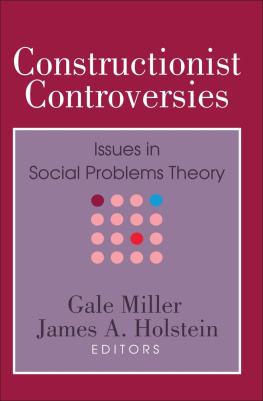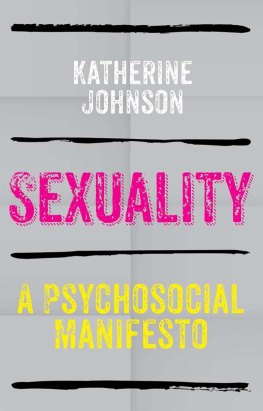SOCIAL CONSTRUCTIONISMS
Social Constructionisms
Approaches to the Study of the Human World
By
Titus Hjelm
Titus Hjelm 2014
All rights reserved. No reproduction, copy or transmission of this publication may be made without written permission.
No portion of this publication may be reproduced, copied or transmitted save with written permission or in accordance with the provisions of the Copyright, Designs and Patents Act 1988, or under the terms of any licence permitting limited copying issued by the Copyright Licensing Agency, Saffron House, 610 Kirby Street, London EC1N 8TS.
Any person who does any unauthorized act in relation to this publication may be liable to criminal prosecution and civil claims for damages.
The author has asserted his right to be identified as the author of this work in accordance with the Copyright, Designs and Patents Act 1988.
First published 2014 by
PALGRAVE MACMILLAN
Palgrave Macmillan in the UK is an imprint of Macmillan Publishers Limited, registered in England, company number 785998, of Houndmills, Basingstoke, Hampshire RG21 6XS.
Palgrave Macmillan in the US is a division of St Martins Press LLC, 175 Fifth Avenue, New York, NY 10010.
Palgrave Macmillan is the global academic imprint of the above companies and has companies and representatives throughout the world.
Palgrave and Macmillan are registered trademarks in the United States, the United Kingdom, Europe and other countries
ISBN: 978-1-4039-3999-9 hardback
ISBN: 978-1-4039-4000-1 paperback
This book is printed on paper suitable for recycling and made from fully managed and sustained forest sources. Logging, pulping and manufacturing processes are expected to conform to the environmental regulations of the country of origin.
A catalogue record for this book is available from the British Library.
A catalog record for this book is available from the Library of Congress.
Typeset by Cambrian Typesetters, Camberley, Surrey
Printed in China
To the memory of Kaarina Hjelm, who was there in the beginning
and
to Lempi Hjelm, who, I hope, will be there in the end.
List of Tables and Figure
Preface and Acknowledgements
I missed the deadline for this book so many times that it is safe to say that I have been thinking about writing it for most of my academic career. The manuscript, in its various stages, has travelled with me not only in time, but through three different universities and three different countries. But, thinking about writing is, of course, one thing and actually writing, another. I am convinced, however, that the more grey hairs my constant delays caused my patient publisher, the more mature is the end result.
Let me tell you why.
More than ten years ago, as a newish PhD student, I experienced one of those revelations that one sometimes has in academia the feeling that an idea or theory sums up what you have been thinking about for some time already. Social constructionism was that idea (if not a theory in a strict sense) for me. Like all recent converts, I read and appropriated constructionist ideas with little critical engagement, although I was starting to discern differences within the field. It was a footnote and a random encounter that started the journey, the end result which is the book you are holding. A footnote in a Finnish textbook on discourse analysis (Suoninen, 1999: 35) encouraged me to think about a book which would focus on the internal differences within social constructionism and the usefulness of constructionism as an umbrella term in the first place. Meeting literary agent Jo Campling at a seminar organized by the Finnish Literature Society encouraged me to put my thoughts on paper in proposal form. And here we are.
My thinking about social constructionism has changed with the times. When I first presented the proposal to Jo, not only was constructionism all the rage in the social sciences, but also something that I personally saw as the most revelatory and liberating perspective on scholarship. Now, of course, constructionism is discussed in less unambiguously positive terms. As everyone who knows my taste in music can tell, Ive never followed fashion, but I have also come to think of constructionism in more critical and detached terms in recent years. For fashion, I should probably call myself a critical realist not that being fashionable necessarily makes an approach less worthy but I like the good old label of constructionist still, even if perhaps a critical constructionist. In this book my point has not been to take a strong position regarding the different traditions of constructionism, but you can probably read this critical perspective between the lines.
Having time to read and learn more is one reason my thinking has evolved. Having had a chance to meet many new and brilliant colleagues during the years is another. Of these, my friends in Helsinki, Amsterdam and London have all had a major impact on my thinking and the overall way I have experienced academic life not to mention the often more fleeting but profound friendships made through international scholarly networks. I am in the happy situation where mentioning all these people would take too many pages, so Ill settle for mentioning those who had a direct impact on the book: Jim Beckford, Steven Engler, Elisa Heinmki, Richard Mole, Atte Oksanen and Jim Spickard read parts or the whole manuscript and gave priceless advice. The usual caveat about the remaining faults being mine applies. I would also like to thank the publishers three anonymous reviewers for helpful comments. It was with great sadness that I learned that Jo Campling, who took me under her wing and got me a contract before I had even finished my PhD, passed away during the writing of the book. Needless to say, I owe her enormously for her trust and open-mindedness. Embarrassingly, the list of people that Ive worked with at Palgrave some of who have already moved on is also too long to be included here. For their patience, a humble thank you to Steven Kennedy, Lloyd Langman, Anna Reeve, Emily Salz and Beverley Tarquini.
Finally, Nora Kajantie shared the writing of the book more often the stresses than the triumphs with me. Not only did she give me her support during the years, but also the worlds most beautiful daughter, Lempi. Love is a social construction, but it is a very real one.
The author and publisher would like to thank Blackwell Publishing Ltd. for permission to reproduce an adapted version of Table 9.1 Theories of moral panics: motives and origin from Moral Panics: The Social Construction of Deviance (1994) by E. Goode and N. Ben-Yehuda.
The World We Make: The Idea of Social Construction
My alarm clock goes off at seven on a normal weekday morning. I get up more often than not sleepy and grumpy and go to the kitchen to put on a kettle for tea. I make breakfast for my daughter and myself, drink my tea, and check the morning headlines in the news, or read a book. After that I take a shower, shave, brush my teeth, comb my hair, put on my clothes, dress my daughter, and take her to the nursery. Arriving at work, I greet the receptionist in the lobby and answer Fine thank you, and you? to a How are you? question asked by a colleague in the school lift. I drop my bag at the office and pop into the mens toilet before the first lecture starts. Entering the classroom, I say Good morning, everyone. Today we are going to discuss social constructionism.





